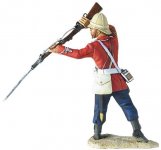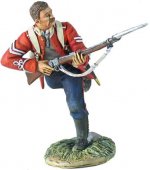2nd Battalion 3rd Regiment of Foot (The Buffs)
The Buffs arrival in Natal and beginning of hostilities
Five Companies of the Buffs arrived in Natal in the summer of 1878 and were scattered around strategically important positions in Natal with the Headquarters being based at Pietermaritzburg. Towards the end of 1878 the Battalion received orders to concentrate at Thring’s Post, twenty miles distant from the mouth of the Tugela River. Upon arrival the Battalion was joined by the other three companies of the Regiment who had been on long detachment in Mauritius thus bringing the Regiment up to a total of 800 men. Shortly after the Battalion’s arrival two companies were sent to construct a large earthwork fort on the right bank of the Tugela River with a commanding view of the drift. The work was successfully concluded and the Buffs named the position ‘Fort Pearson’ in honour of the Battalion’s commanding Officer Colonel Pearson.
By now hostilities between the British and the Zulus had reached a head and the British Governor of the Cape, Sir Henry Edward Bartle Frere had delivered an ultimatum to the Zulu King Cetshwayo, which had to be met by the 11 January 1879.
On the 3 January 1879 the remaining six companies of the Buffs, along with the Headquarters, struck camp at Thring’s Post and arrived at Fort Pearson on the 4 January. From the 4 till 12 January 1879, the Buffs assisted the Naval Brigade in completing the arrangement being made for the Coastal Column’s crossing of the Tugela River, of which the Buffs now formed part.
On the 11 January the time limit on the Governor’s ultimatum ran out with no answer from Cetshwayo and the British were now at war with the Zulu nation.
The Battle of Nyezane
At 8 a.m., while the column was eating its breakfast, a small party of Zulus were spotted and a company of the NNC were sent up the hills to drive the Zulus off. Due to bad communication the NNC bolted upon arrival on the hill leaving their officers to their fate. The Zulus had been lying in wait for the right moment. The Zulus’ discovery by the NNC caused the trap to be sprung prematurely losing the Zulus their advantage of surprise and allowing the British to concentrate their forces.
As the NNC fled back down the hill, Colonel Pearson quickly rushed two companies of the Buffs forward with the Naval Detachment and Artillery to hold the Zulus back on the knoll. The Buffs concentrated their fire on the Zulus coming down the hill ‘with the buzz of a million hornets.’3
At this time more Zulus came into view and it was clear that the Zulus advancing down Wombane were the left horn of the Zulu attack and a third company of the Buffs was rushed forward and placed on the foot of the knoll extended towards the Colonial volunteer units.
Despite the heavy fire, the Zulu’s left horn continued to advance and reached the bush at the bottom of Wombane aiming to reach the wagons that were still crossing the river. The Zulu advance was stemmed by the timely intervention of Captain Wynne of the Royal Engineers who with two companies of the Buffs, now freed up from wagon duty, pushed the Zulus back. At the same time the Naval Marines, along with the Gatling gun, arrived and formed up at the bottom of Wombane and opened fire on the Zulus, causing great execution.
Colonel Welman was still advancing with the second part of the Coastal Column and upon hearing the firing rushed up a half company of the Buffs and 99th Regiment while he hurried forward with the rest of the division.
Upon his arrival, Welman found the battle was beginning to turn against the Zulus. He quickly rushed forward the remaining half companies of the Buffs and 99th Regiment. At this time Commander Campbell led a charge of his Naval Brigade, supported by a company of the Buffs, who succeeded in forcing the Zulus backs towards Wombane.
By 9.30 a.m. the final shot had been fired, the battle of Nyezane was over. The Buffs had lost a total of three men killed and four wounded.
Arrival at Eshowe
Although the Zulu ambush at Nyezane had taken Pearson by surprise he was determined to show the Zulus that they had not stopped his advance and as soon as the dead had been buried, and the Zulu wounded given water and shade from the sun, the advance continued.
The Column arrived at Eshowe on the 23rd and by the end of the day it was safely gathered at the mission station. Work began immediately to prepare the mission as a supply depot and the Buffs took an active part in building the fort that was to protect Eshowe.
On 24 January two companies of the Buffs were sent with a small convoy of wagons back to the Tugela to bring up supplies. At this time members of the NNC present at Eshowe began to hear Zulus on distant hills calling that they had won a great victory. Little notice was taken of this and on 25 January a further two companies of the Buffs with eight wagons were sent back to the Tugela for more supplies. On the journey they met up with the other two companies of the Buffs returning to Eshowe with supplies and news of a dreadful disaster. The second convoy continued to the Tugela where it arrived on 26 January and was ordered to form part of the garrison at Fort Tenedos on the Zulu bank of the river. The first convoy also arrived at Eshowe on 26 January. News of the disaster that had befallen the Centre Column at Isandlwana arrived at Eshowe in various forms from 22 January onwards but it wasn’t until 2 February that the full extent of what had happened became known.
The news left Pearson in a terrible dilemma, as he now had no support on his left flank and was, in effect, surrounded. After a hurried consultation with the other commanding officers of the Column Pearson decided to remain at Eshowe and hopefully encourage the Zulu army to besiege him rather than invade Natal. To reduce the garrison Pearson sent back the Colonial Volunteer formations and NNC regiments thus reducing his garrison to the Royal Artillery, Naval Brigade, Royal Engineers, the Buffs and 99th Regiment.
The Buffs in the Siege of Eshowe
The Buffs settled down into a life under siege, which involved manning the defences and guarding the oxen required to move the wagons. At times the Buffs were involved in small sorties carried out against local Zulu kraals but on the whole the Buffs found themselves largely in the fort. To begin with, life was not too bad at the fort, but as the siege continued outbreaks of disease became rampant and the Buffs, like the rest of the garrison, suffered badly. A total of ten men of the Buffs would die during the siege of Eshowe.
During the early part of March flashes from a signal lamp at the Tugela River could be seen and quickly the garrison tried to make contact through a range of unconventional and unusual methods. Finally, contact was established on 14 March and the garrison was informed that relief was on the way. Pearson quickly decided to start constructing a road from the fort in order to aid the relieving force. The Buffs completed work on this project, often under fire, and soon the road took shape. On 30 March the garrison could see the relief column only 14 miles away and by the 1 April the relief column was across the amaTigulu River. But, before relieving the garrison at Eshowe, the relief column would first have to see off the Zulus in one of the most hard fought yet forgotten battles of the war, a battle that the Buffs were also to play their part in.
The Battle of Gingindlovu and the Relief of Eshowe
Once it became clear that no Zulu invasion of Natal was forthcoming after the disaster of Isandlwana, Lord Chelmsford began to prepare a relief force to march to the relief of the garrison of Eshowe. Among the troops allotted to the relief column were the two companies of the Buffs who had been on garrison duty at Fort Tenedos since escorting the supply convoy from Eshowe back in January.
Due to supply problems and still waiting for arrival of reinforcements, it was not until 29 March that the relief force began to cross the Tugela River and advance to Eshowe. Progress for the relief column was as slow as the advance of Pearson’s Column in January and it was not until 1 April that the relief column came within sight of the Eshowe garrison. The day was spent ferrying the troops across the amaTigulu River and by 2 April the force was in laager.
The battle of Gingindlovu began on 2 April with the relief column’s scouts returning to the laager with the Zulus in hot pursuit after they had been detected. During the battle the two companies of the Buffs held the left front face of the laager and, with a portion of the 99th Regiment, successfully repelled the Zulus during the second phase of the attack. After the battle the two companies of the Buffs remained at the laager while half the relief force-marched to Eshowe, which was relieved on 3 April. It was decided, much to the anger of the defenders, to abandon Eshowe and retreat back to Natal. The force moved off in two columns with Pearson’s force leading. The Zulus made no effort to interfere and the whole British force arrived safely back in Natal.



